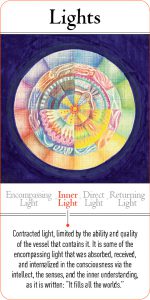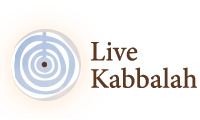Lesson 2 – Part C
The purpose of life – how to get the Light?
In the previous lessons we learned that life/the Universe is a place of very precise rules and the way to make the best out of life is to have the ability to understand the rules of the Universe, and to live by them. We also learned that the first spiritual Universal law/goal is to connect to the Light and to be filled with it. It is our life’s purpose. It is everything we are looking for. Once we have defined this deep seated and elemental goal, the second spiritual Universal law deals with the question: “Where is the Light, how can we find it?”
Where can the Light be found?
 We learned that what we are looking for is actually a feeling that cannot be measured in any material way, not even with our 5 senses or with logic (as we cannot explain or physically touch feelings such as love, success, satisfaction, peace of mind, etc.). That leads us to the conclusion that the search for the desired Light should not be with our 5 senses or logic. However, that poses a problem for us, because all through our lives we were taught tangible skills based on our intellect and 5 senses. Listening to our inner voice and sharpening our intuitive sense are not things one generally learns in common educational programs. Meaning, that the tools (our 5 senses) that have served to protect us, guide us and generally make life possible to live, are in fact, not the most important factors in our lives. What a dichotomy. Our quest to connect to the Light requires us to sharpen and perfect the parts of us that have nothing to do with the 5 senses and logic. Basically, we must learn a whole new skill set that will enable us to open up our world and hearts to the true meaning of life, to be filled with the Light of the Creator.
We learned that what we are looking for is actually a feeling that cannot be measured in any material way, not even with our 5 senses or with logic (as we cannot explain or physically touch feelings such as love, success, satisfaction, peace of mind, etc.). That leads us to the conclusion that the search for the desired Light should not be with our 5 senses or logic. However, that poses a problem for us, because all through our lives we were taught tangible skills based on our intellect and 5 senses. Listening to our inner voice and sharpening our intuitive sense are not things one generally learns in common educational programs. Meaning, that the tools (our 5 senses) that have served to protect us, guide us and generally make life possible to live, are in fact, not the most important factors in our lives. What a dichotomy. Our quest to connect to the Light requires us to sharpen and perfect the parts of us that have nothing to do with the 5 senses and logic. Basically, we must learn a whole new skill set that will enable us to open up our world and hearts to the true meaning of life, to be filled with the Light of the Creator.
The Secret of Success
When we talk about great inventors, leaders with vision or inspiring creators, we are talking about people that have broken through the boundaries of logic and the understanding of the human mind. These people had imagination, vision, inspiration and intuition. Their discoveries left a mark on humanity that will never be forgotten and more than that, they tapped into the world beyond logic and the 5 senses, the place where all possibilities already exist, waiting for the right moment and person to manifest the marvel whose time had come. After the theory of quantum mechanics has been published in the 1920’s, Albert Einstein wrote about some aspects of the theory that the more we study it the more ridiculous it looks. As a result, Niels Bohr, one of the founders of the theory, said that those who think they had understood the quantum theory probably had not, and the more you study it the less you understand it. Still, quantum theory defines our reality. So, he added that probably “what is real is not logic and what is logic is not real”. Meaning, there is no connection between our logic and what is right for us.
Kabbalists say that reality can be divided into two: the World of Truth and the World of Illusion. Everything that can be perceived with our 5 senses happens in the World of Illusion. Everything else is in the World of Truth. This is where all the intangible things we want in life come from (joy, health, passion, excitement, fulfillment, love, etc.).
The World of Illusion is the world we imagine due to the limited information received from our five senses. This is the world in which logic prevails. This world does not really exist except in our imagination. Our reality occurs in the World of Truth, which exists beyond our five senses. It is the world of; vision, inspiration, imagination and intuition – all of these occur frequently however they are not based in logic nor are they measurable by the 5 senses and yet counter to the rules of logic, they exist and occur repeatedly. Many of us have had experiences that have no logical explanation. For example, we are familiar with the situation in which the phone rings and we just know who the caller is, even though we haven’t been in touch with the person for some time. Kabbalah teaches us that everyone can connect to the World of Truth, which gives us inspiration and strength to connect to what we truly want, the Light. Kabbalah coaches us on how we can connect daily to the “Light”, and that leads us to the second spiritual Universal law which defines where we shall look for the Light – in the true dimension of existence.
The second spiritual Universal law:
The logic of the 5 senses is limiting and misleading.
Therefore, we should be focusing on narrowing the influence the 5 senses have on us.
The Language of Branches
Kabbalah teaches that the World of Illusion is very organized and that the disorder and chaos that characterize it, is clearly apparent, because we do not have the ability to see the connection between events that happen in it. We can compare it to a glacier, in the sense that only a tenth of it appears above the water, it is only a shadow that gives limited information about its source. We only see, “the tip of the iceberg”. In this instance, the 5 senses limit our ability to see its true size. They provide only a small part of the picture. And this is how we lead our lives, only understanding parts of what’s going on around us, yet we cannot ignore the information the 5 senses give us as this is the only way we know how to interpret our world. The Kabbalists maintain that this is no way to lead our lives. It is limiting and does not allow us to realize our full potential.
According to Kabbalah, every phenomenon in the World of Illusion is like a branch whose roots stem from the World of Truth. The assumption is that everything we experience, see and hear in the physical world (The world of Illusion) is a branch, or extension, of the World of Truth, like a shadow. Everything we experience with our 5 senses (in the World of Illusion) is actually a “shadow”, a reflection, of something else from the World of Truth.
The worldview of the Kabbalists is that to understand why we behave the way we do, make the choices we do and have the life we do (in the world ruled by our 5 senses), we have to understand the root/seed level of where everything comes from. This can only be found in the World of Truth.
Kabbalists call it “knowing the seed”, which in the language of the branches is like a seed of a tree that contains the totality of the whole tree, including its; branches, roots, fruits, buds and its different characters. Our knowledge of the seeds character helps us to control its growth and development. We know where to plant it, in which season to plant it and how to nurture it into adulthood, in the way that is most beneficial for its optimal life. The same goes for us. Knowing the seed of our life helps us to live the best life we were meant to have, a life with less pain and suffering and more enlightenment and wholeness.
In the next lesson we will learn how to connect to the World of Truth and how to draw from it, inspiration, ideas, spiritual energy and power.
For additional study please enter the course “Level 1 – The Inner World of the Kabbalist” at Live Kabbalah University.
Lesson 1
Part A
What is Kabbalah?
Part B
The Zohar through History
Part C
Kabbalah’s Influence on the Development of Modern Science
Lesson 2
Reality and Illusion, the True World (Olam HaEmet) vs. The False Reality of the bodily senses and mind.
The Language of Branches – The Special Language of the Kabbalists
The Desire and its Fulfillment
Part A
The Rules of Life
Part B
The Way to Happiness
Part C
Logic as a Barrier
Lesson 3
How did it all begin? The Creation of the Universe, The Source of all Souls, What is every Soul made of?
The Big Bang Theory vs. Rabbi Isaac Luria’s Tsimtsum Theory.
What is the source of Evil in this world? The real motivation of the soul vs. Maslow’s Hierarchy of Needs
Part A
Where do we come from?
Part B
Being a Creator
Lesson 4
Good and Evil, Good Inclination and Evil Inclination: Duality as the Source for the Meaning of Life. Free Will: Logic vs. Faith.
Lesson 5
The Tikun doctrine: How everyday’s life is a mirror of the journey the soul is taking. Why do bad things happen to Good People? The Rules of Cause and Effect, Reincarnation in Kabbalistic Teachings.
Lesson 6
Being a Creator – How to understand feelings and emotions? How can we tell between good and evil? The guidance to define negative emotions and the way to transform them.
Lesson 7
Tools for spiritual change:
- Our community.
- The Hebrew letters as an expression of hidden cosmic forces and invisible frequencies – the building blocks of our reality. The marvelous story of the 72 names of the Creator through the unofficial history of the world.
Lesson 8
Basics in Kabbalistic Meditations.
The Name of 42 Letters, The “Ana VeKho’ah” – one of the major holy metitation in the Jewish mystical world.
Lesson 9
“Ets Ha’Haim” – The Tree of Life, Sefirot and Olamot (Worlds).
How is it that The Creator never changes but it looks like He does?
The Cosmology of Good & Evil
The Tetragrammaton.
Lesson 10
The Myths of Messiah, Resurrection of the Dead and the Hebrew Calendar. Prophets of the end of days according to the Kabbalah and the ability to differ between false believes and a guidance to a better future.
To listen to the lessons above, please enter :Live Kabbalah University.
